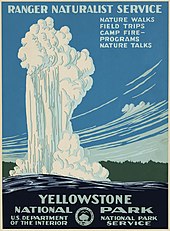
Back Nasionale parke van die Verenigde State Afrikaans قائمة حدائق الولايات المتحدة الوطنية Arabic ABŞ milli parklarının siyahısı Azerbaijani Lis taman nasional ring Amérika Serikat BAN Национални паркове в САЩ Bulgarian Národní parky ve Spojených státech amerických Czech Nationalparker i USA Danish Nationalparks in den Vereinigten Staaten German Naciaj parkoj de Usono Esperanto Anexo:Parques nacionales de Estados Unidos Spanish

The United States has 63 national parks, which are congressionally designated protected areas operated by the National Park Service, an agency of the Department of the Interior.[1] National parks are designated for their natural beauty, unique geological features, diverse ecosystems, and recreational opportunities, typically "because of some outstanding scenic feature or natural phenomena."[2] While legislatively all units of the National Park System are considered equal with the same mission, national parks are generally larger and more of a destination, and hunting and extractive activities are prohibited.[3] National monuments, on the other hand, are also frequently protected for their historical or archaeological significance. Eight national parks (including six in Alaska) are paired with a national preserve, areas with different levels of protection that are administered together but considered separate units and whose areas are not included in the figures below. The 429 units of the National Park System can be broadly referred to as national parks, but most have other formal designations.[4]
A bill creating the first national park, Yellowstone, was signed into law by President Ulysses S. Grant in 1872, followed by Mackinac National Park in 1875 (decommissioned in 1895), and then Rock Creek Park (later merged into National Capital Parks), Sequoia and Yosemite in 1890. The Organic Act of 1916 created the National Park Service "to conserve the scenery and the natural and historic objects and wildlife therein, and to provide for the enjoyment of the same in such manner and by such means as will leave them unimpaired for the enjoyment of future generations."[5] Many current national parks had been previously protected as national monuments by the president under the Antiquities Act or as other designations created by Congress before being redesignated by Congress; the newest national park is New River Gorge, previously a National River, and the most recent entirely new park is National Park of American Samoa. A few former national parks are no longer designated as such, or have been disbanded. Fourteen national parks are designated UNESCO World Heritage Sites (WHS),[6] and 21 national parks are named UNESCO Biosphere Reserves (BR),[7] with eight national parks in both programs.
Thirty states have national parks, as do the territories of American Samoa and the U.S. Virgin Islands. The state with the most national parks is California with nine, followed by Alaska with eight, Utah with five, and Colorado with four. The largest national park is Wrangell–St. Elias in Alaska: at over 8 million acres (32,375 km2), it is larger than each of the nine smallest states. The next three largest parks are also in Alaska. The smallest park is Gateway Arch National Park, Missouri, at 192.83 acres (0.7804 km2). The total area protected by national parks is approximately 52.4 million acres (212,000 km2), for an average of 833 thousand acres (3,370 km2) but a median of only 220 thousand acres (890 km2).[8]
The national parks set a visitation record in 2021, with more than 92 million visitors.[9] Great Smoky Mountains National Park in North Carolina and Tennessee has been the most-visited park since 1944,[10] and had almost 13 million visitors in 2022.[11] In contrast, only about 9,500 people visited the remote Gates of the Arctic National Park and Preserve in Alaska in 2022.[11]
- ^ "National Park System (U.S. National Park Service)". March 15, 2018.
- ^ Yard, Robert Sterling (1931). "Difference Between a National Park and a National Monument". The National Parks Portfolio.
- ^ Sachs, Andrea (August 24, 2016). "What does the National Park Service consider a national park?". The Washington Post.
- ^ "Lower, Rocío (October 17, 2016). "How many national parks are there?". nationalparks.org. National Park Foundation. Archived from the original on February 22, 2017. Retrieved February 24, 2017.
The National Park System encompasses 417 national parks in the United States.... Within the system, 59 sites include 'National Park' as part of their proper name
- ^ "NPS Organic Act Overview". nature.nps.gov. National Park Service. January 17, 2007. Archived from the original on February 6, 2017. Retrieved February 26, 2017.
- ^ "World Heritage List - United States of America". whc.unesco.org. UNESCO World Heritage Centre. Archived from the original on February 25, 2017. Retrieved February 25, 2017.
- ^ "UNESCO » Biosphere Reserves » United States of America". unesco.org. UNESCO. November 2015. Archived from the original on February 22, 2017. Retrieved February 22, 2017.
- ^ "National Park Service Acreage Reports". nps.gov. National Park Service. March 31, 2023. Retrieved May 15, 2023.
"Gross Area Acres" data retrieved from "Listing of Acreage" sheet.
- ^ "Annual Visitation by Park Type or Region for: 2021 By Park Type". Irma.NPS.gov. Retrieved July 9, 2023.
- ^ "National Parks Hosted 237 Million Visitors in 2020 - Office of Communications (U.S. National Park Service)". www.nps.gov. Retrieved February 26, 2021.
- ^ a b "Annual Park Ranking Report for Recreation Visits in: 2022". NPS Stats. National Park Service, U.S. Department of the Interior. Retrieved May 15, 2023.
